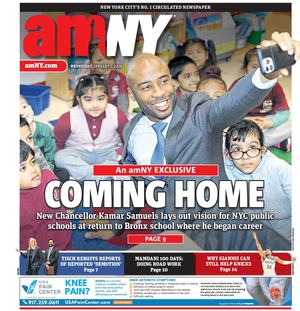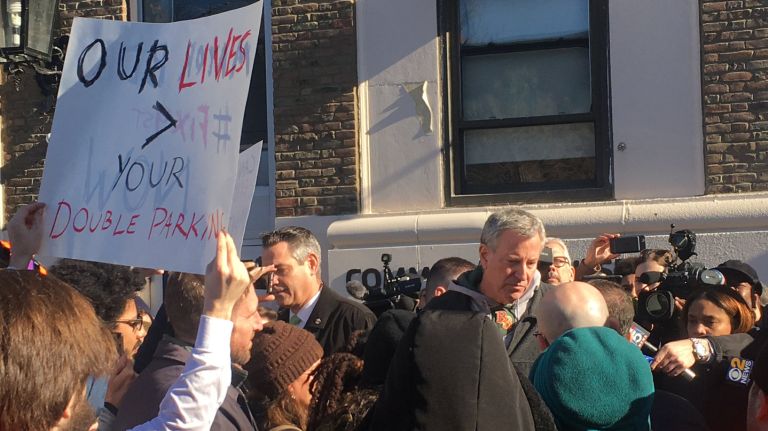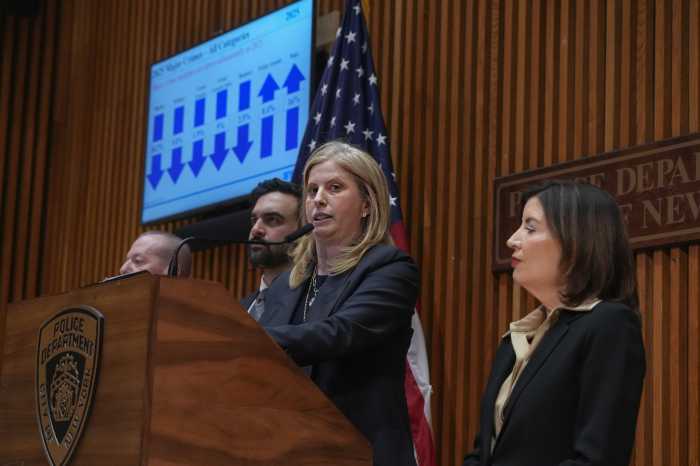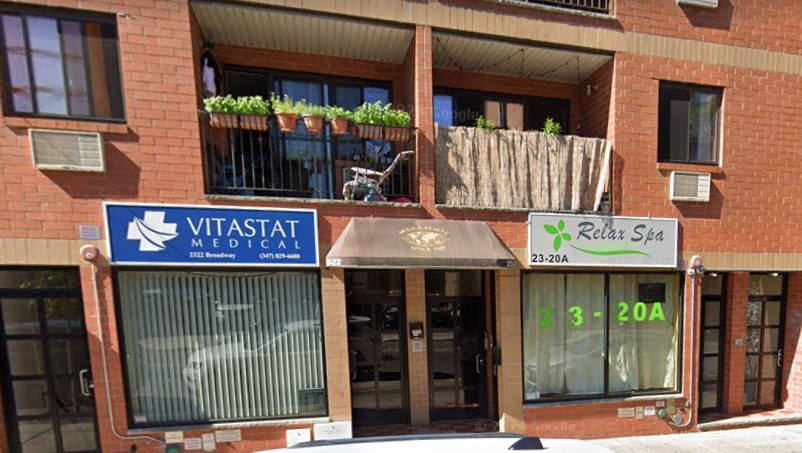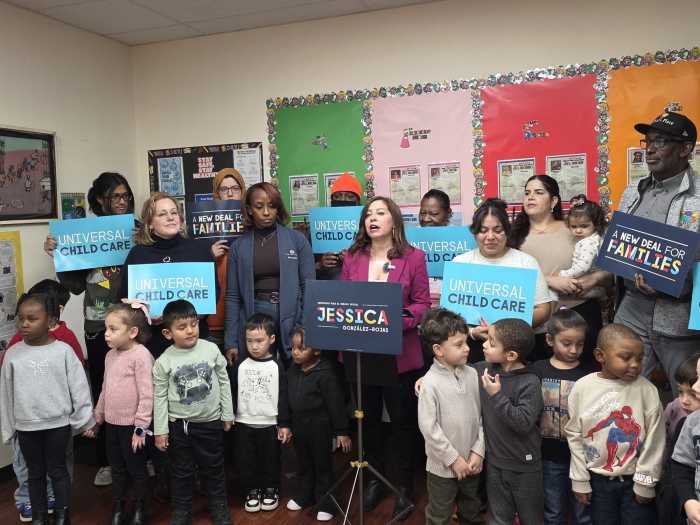
More than 100 New Yorkers gathered outside the Park Slope YMCA Tuesday morning to greet Mayor Bill de Blasio with signs and chants imploring him to more aggressively tackle street safety.
The rally was quickly organized after a deadly collision on Monday afternoon, just up the block at Ninth Street and Fifth Avenue, where two young children were killed and their mothers and another pedestrian were injured after a driver who ran a red light collided into them. Those in attendance called for a redesign of Ninth Street and criticized the slow way the city implements its street redesigns and the penalties for drivers who they believe are not held accountable for reckless behavior.
“We have been calling for changes on this street and streets like it for years, and nothing has been done,” said Park Slope resident and rally organizer Doug Gordon, 43. “Every project that DOT rolls out works. The problem is that every project that they do has to prove itself every time — it has to go to a community board where people fight over parking . . . I think the process is broken.”
The mayor arrived outside the gym shortly before 9 a.m., wearing a gray sweatshirt under a dark fleece. During an unrelated news conference on Monday afternoon, de Blasio called the crash “tragic and painful” and said it was a reminder to “redouble” efforts of Vision Zero, his program to eliminate traffic deaths on city streets. The mayor stopped to speak for several minutes with Gordon, but only briefly addressed the crowd to thank them.
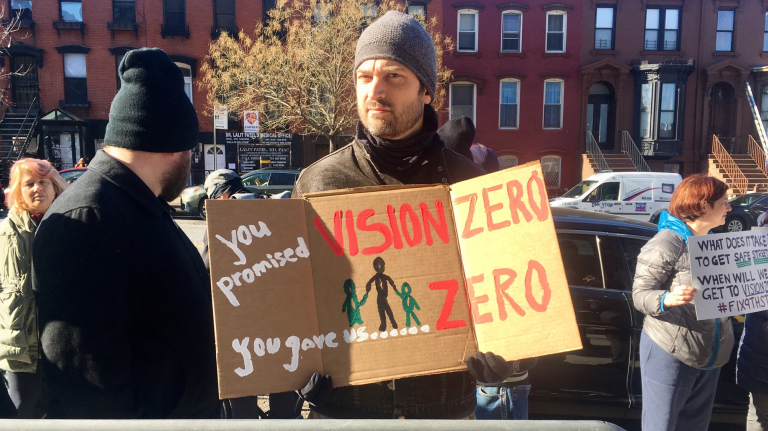
“I make the decision of my own analysis. If I see something that is about safety, again, I will instruct everyone to listen, respectfully, to community boards, to elected officials, to community members,” de Blasio could be heard telling Gordon. “But I ultimately have to make a decision. If it gets to my level, I’m going to make a decision and I’m not worried if there’s political blowback if I think it’s about safety.”
De Blasio went on to say that street redesigns were “one element” of Vision Zero and that enforcement was another key part. He has championed his program for bringing traffic deaths in the city to historic lows — even as nationally, traffic fatalities have increased.
“We need stronger laws; we need more consequence; we need better street design and we need more across the board,” de Blasio said, without specifically outlining how he would achieve those goals. “My job is to protect human life. I’m going to do that even when it’s unpopular.”
Gordon told the press afterward that “I don’t think we got a hard promise” on redesigning Ninth Avenue with safety features like extended pedestrian space, traffic medians or islands, or parking-protected bike lanes.
A few minutes earlier, several Brooklyn elected officials, including Borough President Eric Adams and councilmen Brad Lander and Carlos Menchaca gathered to speak at a makeshift memorial that has been set up for the two children who died in the crash — 1-year-old Josh Lew and 4-year-old Abigail Blumenstein — outside of a Chase Bank on the corner of the crash intersection. Adams laid down flowers.
Just up the block, the crowd outside @NYCMayor’s gym. pic.twitter.com/3wzf41zoD4
— Vincent Barone (@vinbarone) March 6, 2018
The crash is still under investigation, according to police. The 44-year-old driver, identified by a source as Dorothy Bruns, said she believed she’d had a medical episode prior to the collision. A law enforcement source said on Tuesday that Bruns suffers from seizures.
Lander was angered that the vehicle was still on the road. The vehicle involved in the crash had amassed 12 parking and camera violations dating back to July 2016, including four camera violations for speeding in a school zone and another four violations for failing to stop at a red light, according to publicly available city summons data. It’s not clear whether Bruns was the driver of the car when it was assessed with violations.
The crash had unsettled many Park Slope residents. Some brought their small children to the rally Tuesday to voice their displeasure. Sara Gable, 40, said she didn’t believe that de Blasio has been aggressive enough and had been “riding (former Mayor) Bloomberg’s coattails” in terms of street safety fixes.
“It doesn’t feel like substantive change is being made,” Gable said, holding her 2-year-old son. “After something like this happens, I walked here and thought about all the parents leaving with small children and the moments of bravery they’ve had to take every day.”
Investing in pedestrian space
There are ideas out there to redesign streets more quickly. In the afternoon, the advocacy groups Transportation Alternatives and Families for Safe Streets held a pre-planned rally offering their solution to the city: add more protected pedestrian and bike space to streets as the city repaves them each season.
The groups were lobbying City Council members on Tuesday to sign on the idea, outlined in their Vision Zero Street Design Standard manual, to gain support for what they see to be a faster, less outreach-intensive way of re-engineering streets with treatments like painted curb extensions, pedestrian islands and protected bike lanes.
“Really we’re trying to take what has been a political issue and put it more in the science and design space, because the reason these designs aren’t standard doesn’t have to do with the science itself,” said Paul Steely White, executive director of Transportation Alternatives. “It has to do with the city setting science aside to argue whether or not a parking space should still be there in an intersection where people need protected space to cross the street.”
The city aims to repave 1,000 lane miles of roadway each year, and adopting such a plan could significantly increase the number of capital street redesigns the city accomplishes. White said the city would need to make a “modest investment” in personnel to adopt the strategy. Several council members in attendance, including Brooklyn’s Stephen Levin and Manhattan’s Ydanis Rodriguez, agreed that it could and should be achievable.
The city’s Department of Transportation did not immediately respond to a request for comment on the proposal.
“There’s no excuse. We need to make sure it’s in the budget,” said Levin, noting the transportation budget hearing coming up on Thursday at the council. “There needs to be the money in the budget . . . to make sure that these capital improvements are done, we’re not turning down capital improvement projects because of costs.”
